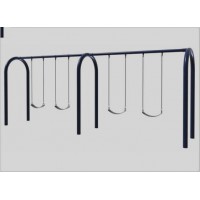Choosing the Correct Playset

Source: 2.5 Equipment Materials
Public Playground Safety Handbook - CPSC Publication 325
U.S. Consumer Product Safety Commission
2.5.1 Durability and finish
• Use equipment that is manufactured and constructed only of materials that have a demonstrated record of durability in a playground or similar setting.
• Finishes, treatments, and preservatives should be selected carefully so that they do not present a health hazard to users.
2.5.2 Hardware
When installed and maintained in accordance with the manufacturer’s instructions:
• All fasteners, connectors, and covering devices should not loosen or be removable without the use of tools.
• All fasteners, connectors, and covering devices that are exposed to the user should be smooth and should not be likely to cause laceration, penetration, or present a clothing entanglement hazard (see also §3.2 (of CPSC Pub. 325) and Appendix B).
• Lock washers, self-locking nuts, or other locking means should be provided for all nuts and bolts to protect them from detachment.
• Hardware in moving joints should also be secured against unintentional or unauthorized loosening.
• All fasteners should be corrosion resistant and be selected to minimize corrosion of the materials they connect. This is particularly important when using wood treated with ACQ/CBA/CA-B2 as the chemicals in the wood preservative corrode certain metals faster than others.
• Bearings or bushings used in moving joints should be easy to lubricate or be self-lubricating.
• All hooks, such as S-hooks and C-hooks, should be closed (see also §5.3.8.1 CPSC Pub 325). A hook is considered closed if there is no gap or space greater than 0.04 inches, about the thickness of a dime.
2.5.4 Paints and finishes
• Metals not inherently corrosion resistant should be painted, galvanized, or otherwise treated to prevent rust.
• The manufacturer should ensure that the users cannot ingest, inhale, or absorb potentially hazardous amounts of preservative chemicals or other treatments applied to the equipment as a result of contact with playground equipment.
• All paints and other similar finishes must meet the current CPSC regulation for lead in paint.
• Painted surfaces should be maintained to prevent corrosion and deterioration.
• Paint and other finishes should be maintained to prevent rusting of exposed metals and to minimize children playing with peeling paint and paint flakes.
• Older playgrounds with lead based paints should be identified and a strategy to control lead paint exposure should be developed. Playground managers should consult the October 1996 report, CPSC Staff Recommendations for Identifying and Controlling Lead Paint on Public Playground Equipment, while ensuring that all paints and other similar finishes meet the current CPSC regulation.3
2.5.5 Wood
• Wood should be either naturally rot and insect resistant(e.g., cedar or redwood) or should be treated to avoid such deterioration.
• Creosote-treated wood (e.g., railroad ties, telephone poles, etc) and coatings that contain pesticides
should not beused.
2.5.5.1 Pressure-treated wood
A significant amount of older playground wood was pres-sure-treated with chemicals to prevent damage from insects and fungi. Chromated copper arsenate (CCA) was a chemical used for decades in structures (including playgrounds).Since December 31, 2003, CCA-treated wood is no longer processed for use in playground applications. Other rot and insect resistant pressure treatments are available that do not contain arsenic; however, when using any of the new treated wood products, be sure to use hardware that is compatible with the wood treatment chemicals. These chemicals are known to corrode certain materials faster than others.
Existing playgrounds with CCA-treated wood
Various groups have made suggestions concerning the application of surface coatings to CCA-treated wood (e.g., stains and sealants) to reduce a child’s potential exposure to arsenic from the wood surface. Data from CPSC staff and EPA studies suggest that regular (at least once a year) use of an oil or water based, penetrating sealant or stain can reduce arsenic migration from CCA-treated wood. Installers, builders, and consumers who perform woodworking operations, such as sanding, sawing, or sawdust disposal, on pressure-treated wood should read the consumer information sheet available at the point of sale. This sheet contains important health precautions and disposal information.
When selecting wood products and finishes for public play-grounds, CPSC staff recommends:
• Avoid “film-forming” or non-penetrating stains (latex semi-transparent, latex opaque and oil-based opaque stains) on outdoor surfaces because peeling and flaking may occur later, which will ultimately have an impact on durability as well as exposure to the preservatives in the wood.
• Creosote, pentachlorophenol, and tributyl tin oxide are too toxic or irritating and should not be used as preservatives for playground equipment wood.
• Pesticide-containing finishes should not be used.
• CCA-treated wood should not be used as playground mulch.
2.6 Assembly and Installation
• Strictly follow all instructions from the manufacturer when assembling and installing equipment.
• After assembly and before its first use, equipment should be thoroughly inspected by a person qualified to inspect playgrounds for safety.
• The manufacturer’s assembly and installation instructions, and all other materials collected concerning the equipment, should be kept in a permanent file.
• Secure anchoring is a key factor to stable installation, and the anchoring process should be completed in strict accordance with the manufacturer’s specifications.
COPYRIGHT 2010 DunRite PLAYGROUNDS

